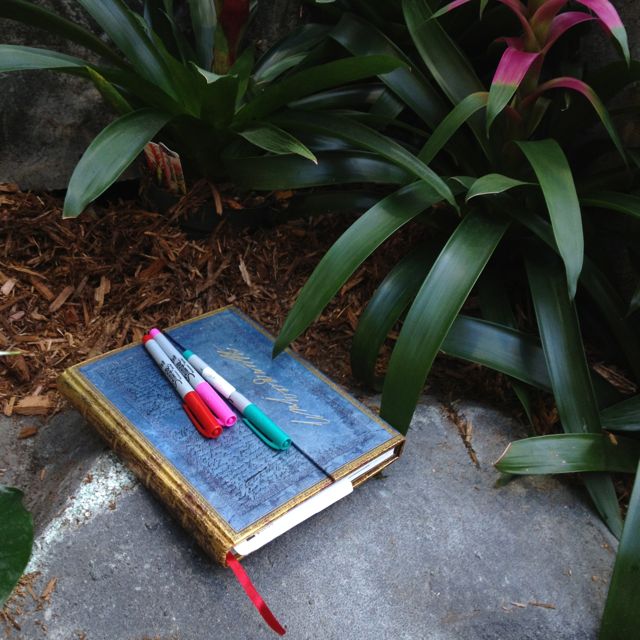by Heather Plett | Mar 1, 2014 | women
 At my recent person retreat, I played with art supplies in the art room, and this piece of art emerged. What’s written below comes directly from the pages of my journal, intuitive and uncensored.
At my recent person retreat, I played with art supplies in the art room, and this piece of art emerged. What’s written below comes directly from the pages of my journal, intuitive and uncensored.
She Who Sees is Rising
It all started with the shrouded eyes, staring out at me from the front cover of a magazine. A woman hidden by a burka, and yet her eyes are watching. Seeing. Learning. Spying. Waiting.
She is silent now, shrouded by the patriarchy. Shrouded by those who are afraid of her power. She is hidden, draped in black, her sensuous curves too dangerous for the men who want her, who deny themselves her beauty. She is oppressed, beaten, raped, tortured, abused. She is mined for her resources, used for what she can offer. And then hidden, pushed aside.
They are afraid of her. She is too powerful. She is fierce and wild and untameable. She is a feral creature, gnashing her teeth at her captors. They fear her and so they trap her.
But from the bars of her cage, she is always watching. Waiting. Holding her strength in reserve for when she is ready. Waiting for the sisterhood to come of age alongside her. Waiting for the power to build up until the pressure valve erupts and she explodes into the world.
She is ready. Her sisterhood is gathering. Her captors are losing their power. They are wasting their strength, fighting each other and building their fragile empires.
She will rise. She will emerge like a phoenix from the flame. No cage will be able to hold her. No shroud will be able to hide her.
She will rise and take her rightful place. She will birth herself into the world. She will hold nothing back.
In her rising, she will silence the oppressors and then she will bandage their wounds. She will halt the destruction of the earth and then she will invite the destroyers to gather round the campfire.
She is fierce and she is a healer. She is powerful and compassionate. She will not hold back and she will offer a soft place to land. She will destroy and she will rebuild. She will fight and she will gather. She is a warrior and a lover. She is dangerous and she is safe. She is bold and she is humble.
She is rising. Her sisterhood rises with her. She will no longer be silent. She will no longer wait for her turn to speak. She will no longer watch her sons go to needless wars. She will no longer let her Mother be raped for her resources.
She is me. She is every woman. She is power. She is love. She is our future. She is our ancient lineage. She is our forests. She is our hearths. She is our food. She is our food. She is our hope. She is our beloved. She is rising.
We rise with her.
by Heather Plett | Feb 26, 2014 | Uncategorized
 Note: Read all the way to the end of this post to find out how to enter to win free registration to Spectrum: A holistic visual journaling workshop.
Note: Read all the way to the end of this post to find out how to enter to win free registration to Spectrum: A holistic visual journaling workshop.
“All transitions are composed of an ending, a neutral zone and a new beginning” – William Bridges
In my last post, I talked about how the journey from Story A to Story B is almost always longer and more complex than we expect it to be. As the second diagram suggests, we must enter the labyrinth of transformation, release the old story on the journey in, sit quietly at the centre and wait patiently to receive what is there for us, and then make the return journey out of the labyrinth and into the new story that’s ready to emerge.
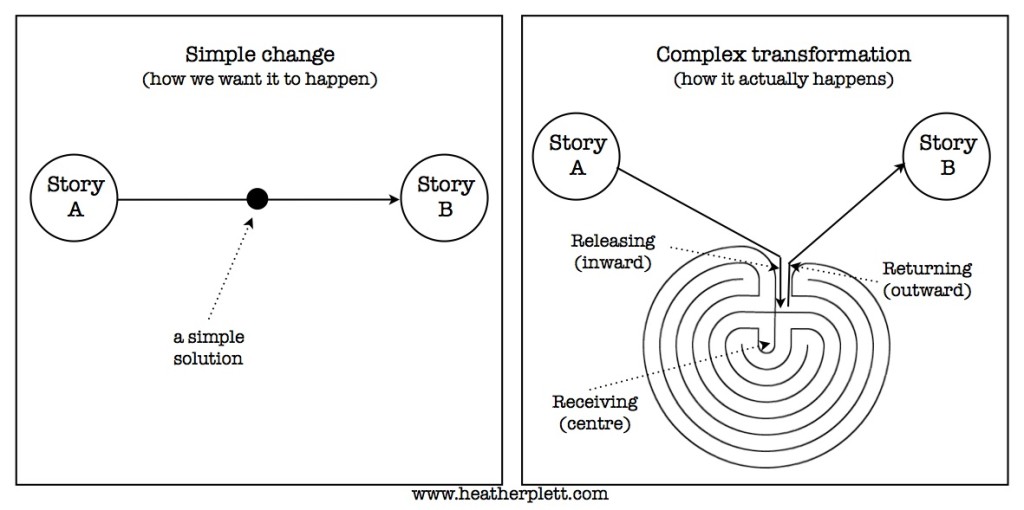 Several people have contacted me to say that the post resonated and that they find themselves in that in-between place. Some of them express their discomfort and want to know “what should I be doing in the in-between place?”
Several people have contacted me to say that the post resonated and that they find themselves in that in-between place. Some of them express their discomfort and want to know “what should I be doing in the in-between place?”
Here are some of my thoughts on how to live in the in-between place:
1. Let go of the mindset that you have to DO something. We are products of a culture that has convinced us that in order to have value, we must be active, we must produce things, and we must – at all costs – stay busy. I know it’s hard to break away from old patterns, but that mindset will not serve you well in this journey. New seeds do not grow on ground that is plowed every day. Nor can the land continue to be fruitful if it is not allowed to lie dormant through the winter. We need to learn a lesson from trees, release our fruit in the harvest season, release our leaves so that our trunks do not need to keep pumping sap through them and risk freezing, and simply lie dormant over the quiet season. Only then will we be ready to receive what is waiting for us at the centre. Only then can the new story begin to grow.
2. Be quiet. “To every thing there is a season, and a time to every purpose under the heaven… a time to keep silence, and a time to speak.” (Ecclesiastes 3) The in-between place is not a time for a lot of noise or conversation. It’s a more introverted time – a time to sit in your own silence and wait patiently for the wisdom to come. Turn off social media, cancel the parties, and just be quiet with yourself for awhile. The deepest wisdom in our hearts can’t be heard above the noise. If you can, go away for a silent retreat for a few days, or at least find time regularly to wander in the woods or in labyrinths.
3. Find the practices that sustain you and take you to a deeper place. This may be the time to bring in a new practice – dancing, yoga, meditation, Mandala Discovery, art journaling, walking, photography, etc. Find something that helps you get in touch with yourself and release the old stories.
4. Find an incubator where the new story can begin to grow in safety. It’s hard to believe in the new story that’s emerging if everyone you know is still stuck in old stories. To nurture your new story, find places where you feel safe trusting in what is possible. Find people (online or in person) who are also inviting in new stories and be intentional about supporting each other and growing new stories together.
5. Break away from the things that keep you stuck in the old story. This may mean you have to walk away from old jobs and unhealthy relationships. It may mean giving up some of your volunteer commitments that keep you too busy to walk the labyrinth. Be courageous in seeking what you know you need to get through this. Practice saying “no, this is not what I need right now”.
6. Be as honest as you need to be with the people around you. Be clear about your needs. You may need to tell your life partner “I need to be by myself for awhile. This is not about you – it’s about what I need for this transition I’m going through. I would appreciate your support.” It may mean you’ll need to tell your Mom “This is what is now true for me. It might make you uncomfortable, and it might not be true for you, but I’m asking you to respect my journey anyway.”
7. Allow yourself to grieve and to hospice the old story into its death. You’re letting go of something important. It’s a story that has sustained you for a long time. Don’t take that lightly. Allow yourself to properly grieve its loss. Don’t rush through the sadness or any of the other emotions that show up. Offer respect and gratitude to the old story for the role it played in your life. Give yourself permission to really feel this pain.
8. Be patient. The most difficult thing about this in-between place is that it doesn’t end as quickly as we want it to. Old stories need time to die. New stories need time to germinate. You won’t serve either story well if you rush from one to the next. You won’t serve yourself well if you don’t take the time that’s needed in between.
9. Remember that your journey is your own. No two journeys through this will look the same, so you’ll need to trust your own wisdom to get you through. You can seek advice from other people, read books about it, or take classes, but at the end of the day, nobody can know exactly what you need except for you. Trust that. Learn to listen for the voice of intuition.
10. Lean on a Higher Power. You’re not walking through this alone. God/dess wants to walk the journey with you, supporting you and holding you up when you get weary. Practice doing the things that help you get in touch with the God of your understanding – pray, meditate, be in nature, go to the synagogue, etc. Trust that something bigger than you wants this new story to emerge just like you do.
What’s your experience of the in-between place? Do you have any other points you’d like to add or any questions you’d like to ask? Add a comment to this post for your chance to win free registration to Spectrum: A holistic visual journaling workshop (where I’ll be teaching a workshop related to this post, on an art journal process inspired by labyrinths). Contest closes Friday, February 28 at 8:00 p.m. central.
Also, don’t forget that you have until Saturday morning to register for Mandala Discovery.
Note: All links to Spectrum are affiliate links, which means I’ll get a portion of the registration fees if you register through these links.
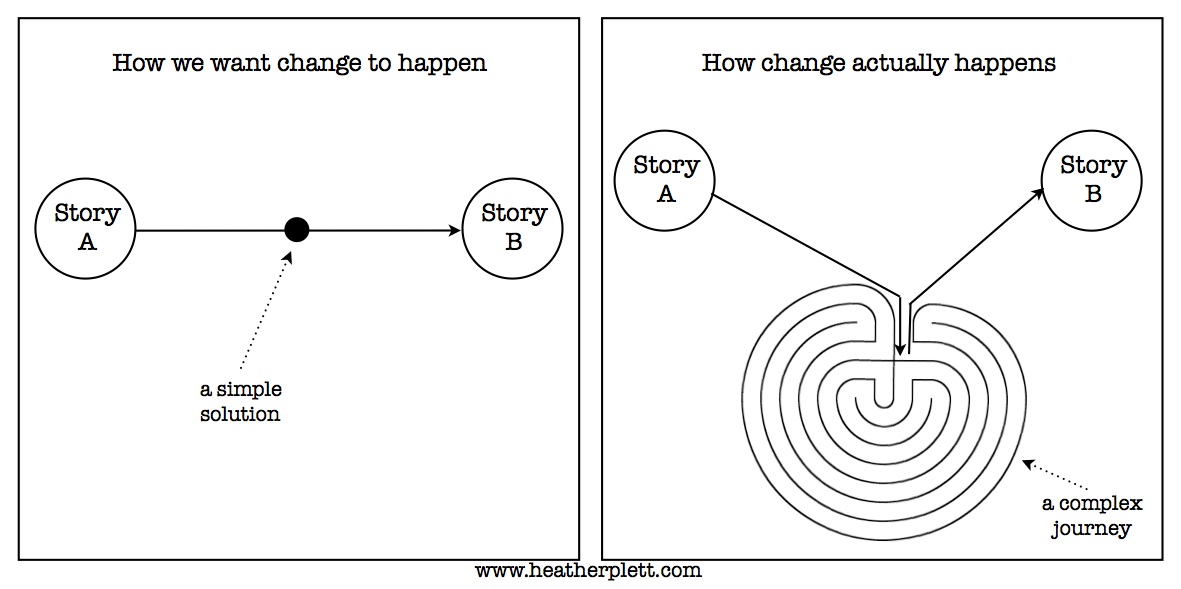
by Heather Plett | Feb 24, 2014 | change
“Do not be afraid of the empty place. It is the source we must return to if we are to be free of the stories and habits that entrap us.” – Charles Eisenstein
I’ve been having a lot of internal dialogues lately, and one of the conversations sounds a lot like this:
Me 1: “Mandala Discovery starts again on Saturday. Why aren’t you doing a better job of marketing it?”
Me 2: “I don’t know. I’m really struggling with marketing lately. Marketing language gets stuck in my throat.”
Me 1: “But you don’t have to be a traditional marketer to make this work. You just have to offer affiliate programs for past participants, buy Facebook ads, send out multiple reminders to your list, blah, blah, blah. Oh… And you have to be more clear about what they get for their investment. People don’t understand just how good Mandala Discovery is because your language is too vague.”
Me 2: “But… The trouble is, I can’t tell them exactly what they’ll get for their investment. Every journey through this will be different and they’ll each find what they need on the journey. I can’t tell them what need will be filled because I don’t know their unique needs.”
Me 1: “How do you think you’ll ever be a successful entrepreneur if you don’t learn to speak in clear marketing lingo? You’ve worked in PR for a long time – surely you know how to tell the story that will sell the product. ‘You want to get to Story B and you’re stuck at Story A? Buy this simple product and you’ll have guaranteed success.’”
Me 2: “That really doesn’t work for me. Nothing I sell fits into the ‘simple product’ category. I don’t offer simplicity. I offer complexity. I invite people into the ‘empty place’ (that Charles Eisenstein talks about in that quote at the top of this page). You can’t put that empty place on a sales page.”
And so it goes, on and on, with Me 1 trying to be more financially successful and Me 2 trying to be more authentic.
Me 2 usually wins, but Me 1 is stuck in some old stories about worthiness and conventional wisdom, and so the dialogue continues.
Last week, I had a series of a-ha moments that have helped me clarify my work even further. First of all, I was working with the leadership team of a local organization that was going through a major transition. When I did individual coaching with each of the people involved, I realized that the stories they were each living in were not in alignment with the direction the organization was heading. In the group conversation I hosted, these stories started coming out, and they realized that the true story that was emerging was very different from what they’d thought was needed. Embracing this true story meant that they would have to release something that was very important for all of them, and possibly even close the doors of the business. This came with a lot of grief that they will have to work through in the coming months. I was reminded, as I held the container for their stories to emerge, that part of my work is to help people and organizations navigate this difficult journey of grief and change in an authentic way.
The work I deeply believe in is not a simple step from Story A to Story B – it’s the releasing of Story A, living in the complexity and grief of that loss, and then being in the empty place where Story B can begin to emerge.
A similar thing happened in my coaching work recently. A client had hired me for three sessions, and in the first session a few months ago, she was trying to decide what her true work was and whether she should leave her job or change jobs to step into something new that felt more purposeful. Finally, however, in the third session, she admitted what she really wanted. “I don’t really want to have a purpose right now. I just want to BE for awhile. I don’t want to DO. I just want to give myself permission to SIT.”
And so, instead of giving her ten easy steps on how to move from story A to story B, we worked on what that empty place would look like and how she could give herself permission to be in it, spending time in play and stillness. She’s now got plans to go away on a personal retreat and to spend time creating a quilt that has no planned outcome, design, or recipient.
Again and again, as I do this work, I hear the longing in people’s hearts for real transformation. In the longing is the assumption (or desperate hope, or outside pressure of family and friends) that they can find a simple fix that will help them move from Story A to Story B. That’s what the marketers have been telling us for years, and so that’s what we want to believe. “Buy this car and you’ll finally feel good about yourself. Use this skin cream and you’ll never age. Take this course and your confidence will grow. Sign up for these coaching sessions and you’ll magically be ready to step into your bigness.”
But when I go deeper with my clients, they recognize that their authentic journeys have nothing to do with the easy steps the marketers want to sell them. Real transformation doesn’t work that way. Real transformation is much more complex and nuanced, and doesn’t fit into bullet points.
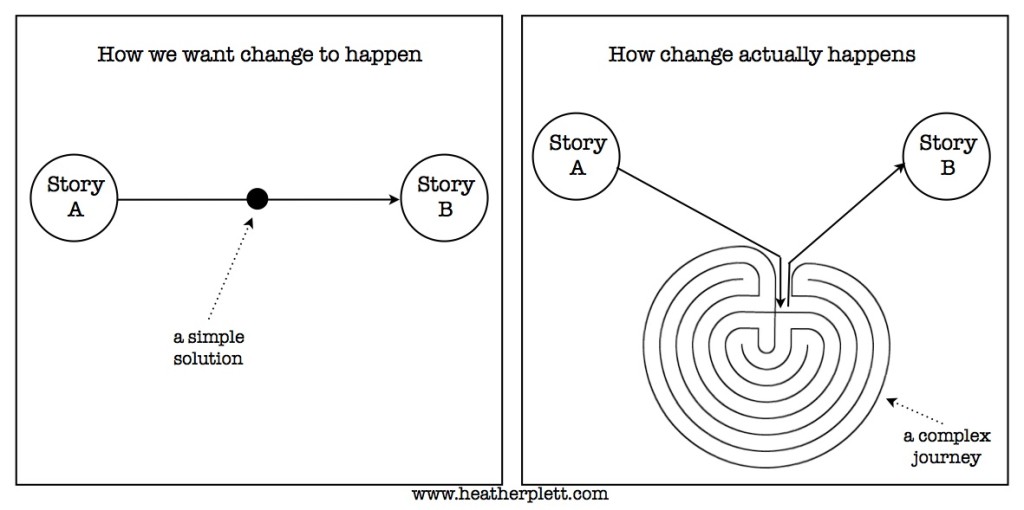
As the illustration suggests, we all want the bullet points that will help us take a direct path from Story A to Story B. But the truth is, the bullet points short circuit the change and Story B doesn’t really have an opportunity to grow out of it.
If we really want Story B to emerge, we have to be willing to let go of Story A, take the winding journey through the labyrinth, and wait for Story B to emerge naturally.
There are three stages to the labyrinth journey. When we journey inward, we release. When we cross the threshold and stand at the centre, we receive. When we journey outward, we return. But we don’t return to Story A. We take what we have received at the centre, we allow ourselves to be transformed, and we follow where the path is leading to Story B.
It’s easy to sell the bullet point, but it’s much harder to sell the labyrinth.
Nobody wants to step into complexity and messiness. Nobody wants to feel lost and confused.
We want short cuts through the grief and emptiness that comes when we let go of Story A, and so we go shopping, we overeat, we sign up for courses, and we try to bury our fear in staying busy. Instead of sitting still at the centre of the labyrinth, we rush to find our new purpose.
Instead of releasing and stepping into trust, we hang on tightly to stories that no longer serve us.
Instead of risking the pain of growth, we try to fool ourselves with the ten easy steps to a better life.
In The More Beautiful World Our Hearts Know Is Possible, Charles Eisenstein talks about The Story of Separation that the world has been living in. That’s a story that keeps us locked in a financial economy that demands growth and the pillaging of the earth for the resources that feed that growth. It’s a story that has us living as separate, self-sufficient individuals instead of in community. It’s a story that requires a greater and greater investment in military actions that help us protect our resources and our self-sufficiency.
The new story that the world is longing for is a Story of Connection. It’s a story that brings us back to a healthy relationship with each other and the earth. It’s a story of trust and compassion, community and spirituality.
As the diagram shows above, we won’t get to the Story of Connection until we are ready to release the Story of Separation, step into the centre of the labyrinth, and receive the new thing that wants to be born in each of us.
I want to be part of that Story of Connection, and that is why I will never sell you what you don’t need, or try to convince you that anything I offer will provide you with an easy solution.
I won’t get rich doing this work, but that’s not one of my values anyway. Getting rich would simply help me hang onto that Story of Separation.
What I would much rather do is invite you to let go of the stories that no longer serve you and step into the labyrinth with me.
I can’t promise you that it will be easy or that the path will be smooth. From personal experience, I know that transformation is rarely easy or smooth. There will be grief, you will have to step into the shadows, and there will be moments when you’ll feel completely lost. Some days, in fact, you will probably regret that you accepted my invitation to step onto this journey.
In the end, though, it will be worth it. The new story will be more beautiful than anything you’ve had to release. You will gradually find your way into your authentic heart, and that is the most beautiful place that you can live. Along the journey you will find other pilgrims who are also finding their way through the grief and shadows, and you will discover that being in community is much better than living a self-sufficient life.
If this is a place you’d like to go, then I invite you to start with Mandala Discovery. You’ll receive 30 prompts that will guide you through a labyrinthian journey into your own heart.
If you want to go even deeper, consider one-on-one coaching and/or a journey through Lead with Your Wild Heart.
p.s. In my desire to live in the gift economy, I look for ways to support people that doesn’t involve financial transactions. If you are interested in any of my programs and do not have sufficient financial resources, please contact me to see if we can work something else out.
by Heather Plett | Feb 17, 2014 | Uncategorized
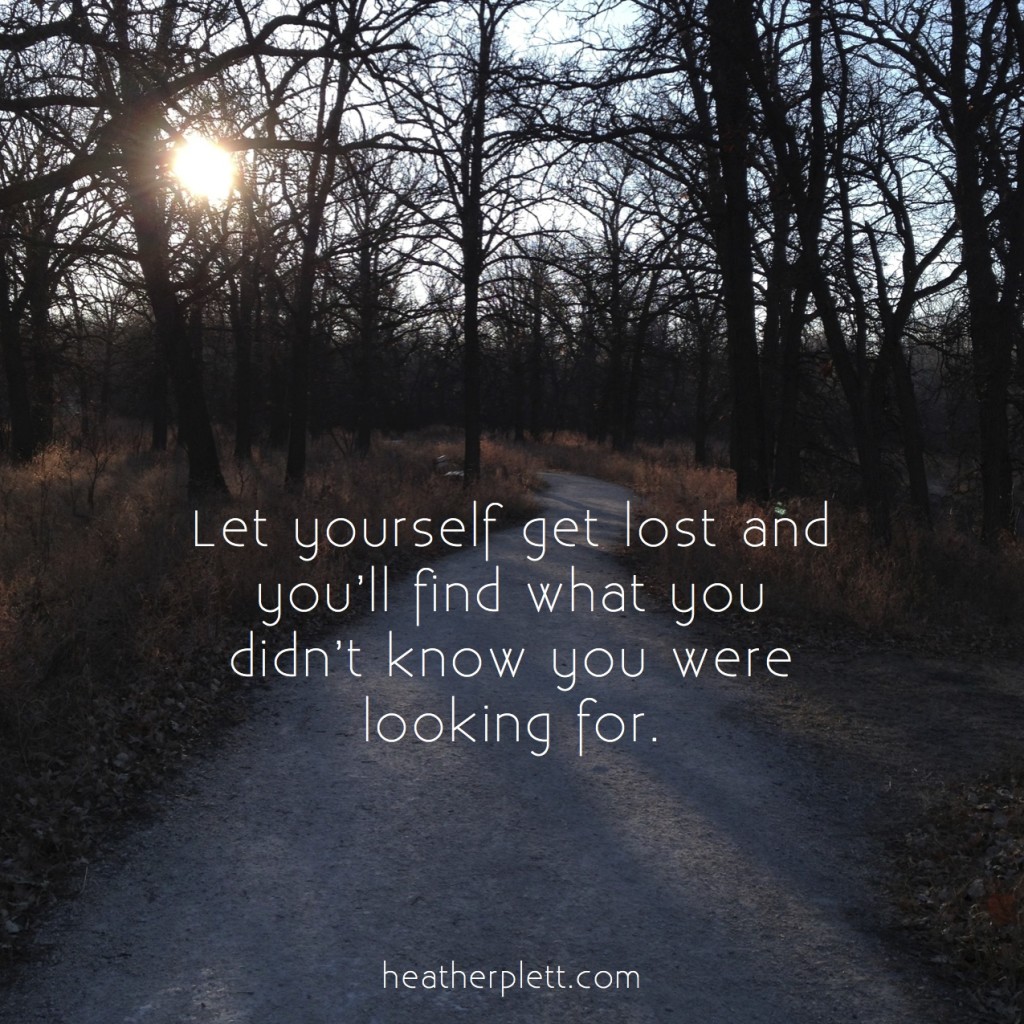 There’s a meme floating around on Facebook. A six word memoir. Write your life in six words. Here’s what I wrote…
There’s a meme floating around on Facebook. A six word memoir. Write your life in six words. Here’s what I wrote…
Lost and found. Again and again.
This is my life.
Walking the path I think is mine,
Until it doesn’t feel like mine anymore.
Finding myself profoundly lost.
Floundering in the dark until light peeks through the shadows.
Finding my way back to myself.
Finding ease for awhile, and then…
Entering another dark place.
Lost. Again.
Sometimes by my own choosing,
And sometimes guided by circumstances.
At first it felt like I was doing something wrong,
Like I just wasn’t as good as everyone else at finding direction.
Like I was doomed to wander in the world,
Never finding the kind of clarity others seem to have.
Then I learned that this is the right way.
Lost and found. Again and again.
Each time, going deeper.
Each time, learning to understand the darkness more.
Each time, finding new truths about myself.
Finding those secrets I wouldn’t know if I were always found.
The lost place is the place where truth whispers.
The place where wisdom shines through the dark.
The place where I learn to let go.
The place where I learn to trust.
The lost place is where I finally get found.
Where I finally remove the mask.
Where I finally release what no longer serves.
Where I finally give in to what wants to be born.
The lost place is my salvation.
My surrender.
My birth.
My letting go so that I can be found.
Lost and found. Again and again.
Note: Are you finding yourself lost again? A journey through Pathfinder might help.
 At my recent person retreat, I played with art supplies in the art room, and this piece of art emerged. What’s written below comes directly from the pages of my journal, intuitive and uncensored.
At my recent person retreat, I played with art supplies in the art room, and this piece of art emerged. What’s written below comes directly from the pages of my journal, intuitive and uncensored.





